Set Meaningful Employee Performance Measures
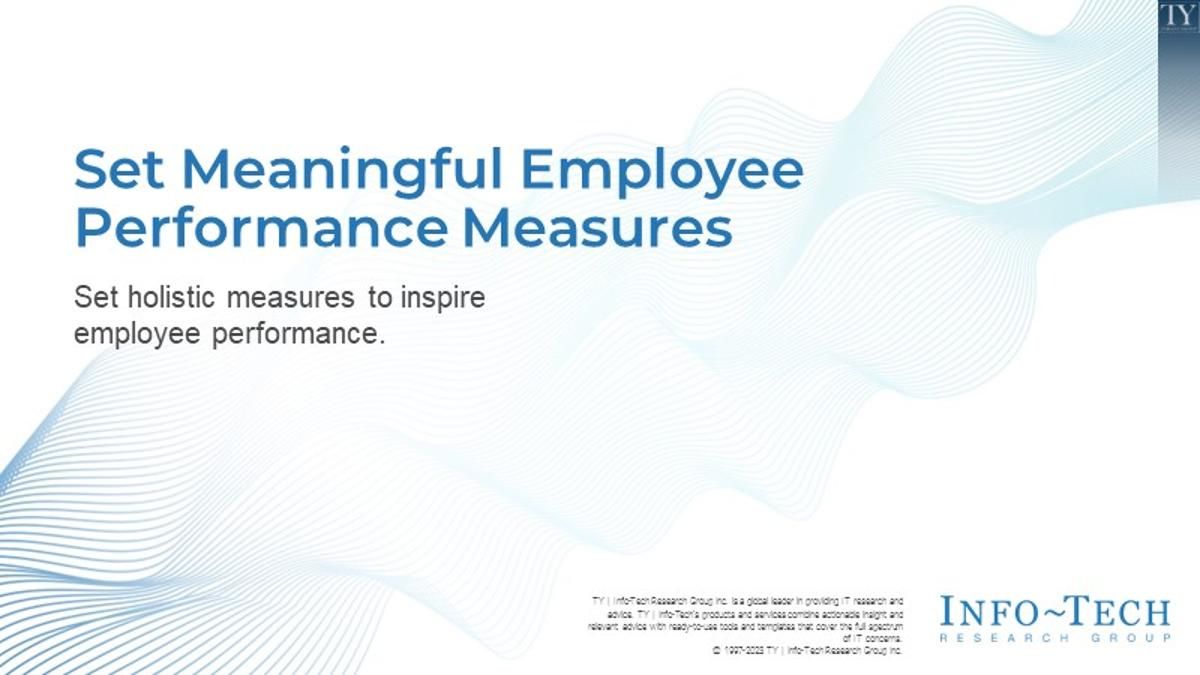
- Despite the importance of performance measures, most organizations struggle with choosing appropriate metrics and standards of performance for their employees.
- Performance measures are often misaligned with the larger strategy, gamed by employees, or too narrow to provide an accurate picture of employee achievements.
- Additionally, many organizations track too many metrics, resulting in a bureaucratic nightmare with little payoff.
Our Advice
Critical Insight
- Focus on what matters by aligning your departmental goals with the enterprise's mission and business goals. Break down departmental goals into specific goals for each employee group.
- Employee engagement, which results in better performance, is directly correlated with employees’ understanding what is expected of them on the job and with their performance reviews reflecting their actual contributions.
- Shed unnecessary metrics in favor of a lean, holistic approach to performance measurement. Include quantitative, qualitative, and behavioral dimensions in each goal and set appropriate measures for each dimension to meet simple targets. This encourages well-rounded behaviors and discourages rogue behavior.
- Get rid of the stick-and-carrot approach to management. Use performance measurement to inspire and engage employees, not punish them.
Impact and Result
- Learn about and leverage the McLean & Company framework and process to effective employee performance measurement setting.
- Plan effective communications and successfully manage departmental employee performance measurement by accurately recording goals, measures, and requirements.
- Find your way through the maze of employee performance management with confidence.
Set Meaningful Employee Performance Measures Research & Tools
Besides the small introduction, subscribers and consulting clients within this management domain have access to:
1. Set Meaningful Employee Performance Measures Storyboard – This deck provides a comprehensive framework for setting, communicating, and reviewing employee performance measures that will drive business results
This research will help you choose an appropriate measurement framework, set effective measures. and communicate and review your performance measures. Use Info-Tech's process to set meaningful measures that will inspire employees and drive performance.
- Set Meaningful Employee Performance Measures Storyboard
2. Employee Performance Measures Goals Cascade – A tool to assist you in turning your organizational goals into meaningful individual employee performance measures.
This tool will help you set departmental goals based on organizational mission and business goals and choose appropriate measures and weightings for each goal. Use this template to plan a comprehensive employee measurement system.
- Employee Performance Measures Goals Cascade
3. Employee Performance Measures Template – A template for planning and tracking your departmental goals, employee performance measures, and reporting requirements.
This tool will help you set departmental goals based on your organizational mission and business goals, choose appropriate measures and weightings for each goal, and visualize you progress toward set goals. Use this template to plan and implement a comprehensive employee measurement system from setting goals to communicating results.
- Employee Performance Measures Template
4. Feedback and Coaching Guide for Managers – A tool to guide you on how to coach your team members.
Feedback and coaching will improve performance, increase employee engagement, and build stronger employee manager relationships. Giving feedback is an essential part of a manger's job and if done timely can help employees to correct their behavior before it becomes a bigger problem.
- Feedback and Coaching Guide for Managers
Infographic
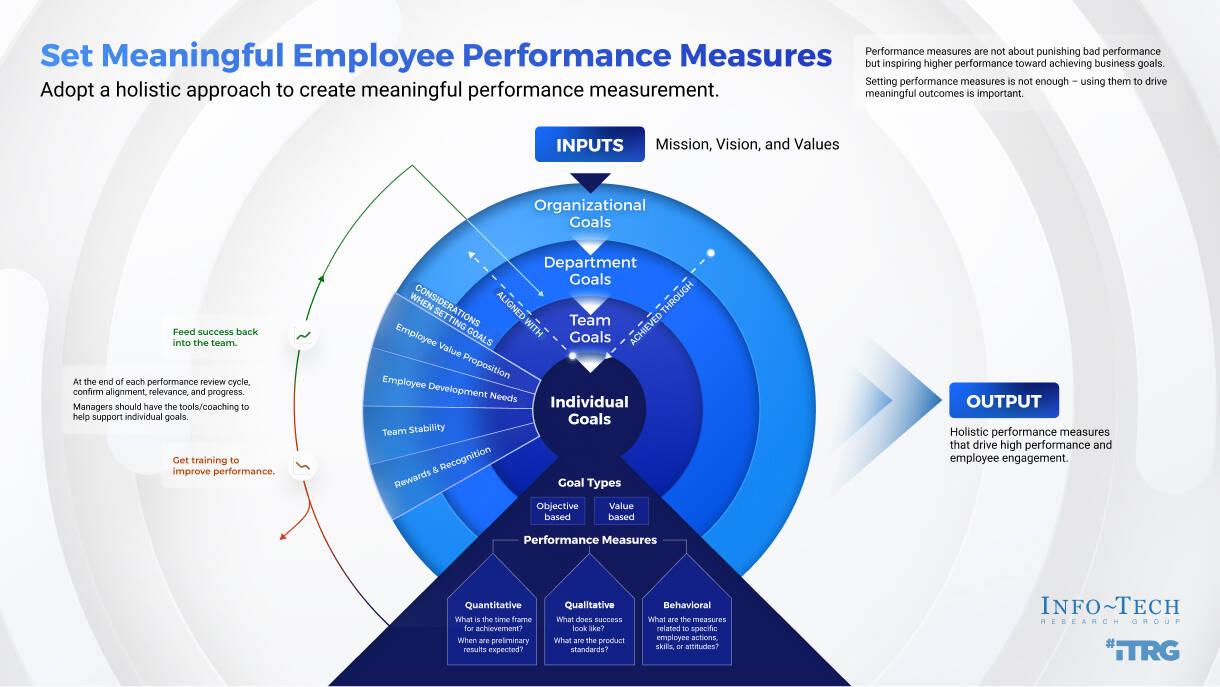
Workshop: Set Meaningful Employee Performance Measures
Workshops offer an easy way to accelerate your project. If you are unable to do the project yourself, and a Guided Implementation isn't enough, we offer low-cost delivery of our project workshops. We take you through every phase of your project and ensure that you have a roadmap in place to complete your project successfully.
1 Source and Set Goals
The Purpose
Ensure that individual goals are informed by business ones.
Key Benefits Achieved
Individuals understand how their goals contribute to organizational ones.
Activities
1.1 Understand how your department contributes to larger organizational goals.
1.2 Determine the timelines you need to measure employees against.
1.3 Set Business aligned department, team, and individual goals.
Outputs
Business-aligned department and team goals
Business-aligned individual goals
2 Design Measures
The Purpose
Create holistic performance measures.
Key Benefits Achieved
Holistic performance measures are created.
Activities
2.1 Choose your employee measurement framework: generic or individual.
2.2 Define appropriate employee measures for preestablished goals.
2.3 Determine employee measurement weightings to drive essential behaviors.
Outputs
Determined measurement framework
Define employee measures.
Determined weightings
3 Communicate to Implement and Review
The Purpose
Learn how to communicate measures to stakeholders and review measures.
Key Benefits Achieved
Learn how to communicate to stakeholders and coach employees through blockers.
Activities
3.1 Learn how to communicate selected performance measures to stakeholders.
3.2 How to coach employees though blockers.
3.3 Reviewing and updating measures.
Outputs
Effective communication with stakeholders
Coaching and feedback
When to update
4 Manager Training
The Purpose
Train managers in relevant areas.
Key Benefits Achieved
Training delivered to managers.
Activities
4.1 Deliver Build a Better Manager training to managers.
4.2
Outputs
Manager training delivered
Further reading
Set Meaningful Employee Performance Measures
Set holistic measures to inspire employee performance.
EXECUTIVE BRIEF
Set employees up for success by implementing performance measures that inspire great performance, not irrelevant reporting.
Executive Summary
Your ChallengeIn today’s competitive environment, managers must assess and inspire employee performance in order to assess the achievement of business goals. Despite the importance of performance measures, many leaders struggle with choosing appropriate metrics. Performance measures are often misaligned with the larger strategy, gamed by employees, or are too narrow to provide an accurate picture of employee achievements. |
Common ObstaclesManagers who invest time in creating more effective performance measures will be rewarded with increased employee engagement and better employee performance. Too little time setting holistic employee measures often results in unintended behaviors and gaming of the system. Conversely, too much time setting employee measures will result in overreporting and underperforming employees. |
Info-Tech’s ApproachInfo-Tech helps managers translate organizational goals to employee measures. Communicating these to employees and other stakeholders will help managers keep better track of workforce productivity, maintain alignment with the organization’s business strategy, and improve overall results. |
Info-Tech Insight
Performance measures are not about punishing bad performance, but inspiring higher performance to achieve business goals.
Meaningful performance measures drive employee engagement...
Clearly defined performance measures linked to specific goals bolster engagement by showing employees the importance of their contributions.
Significant components of employee engagement are tied to employee performance measures.
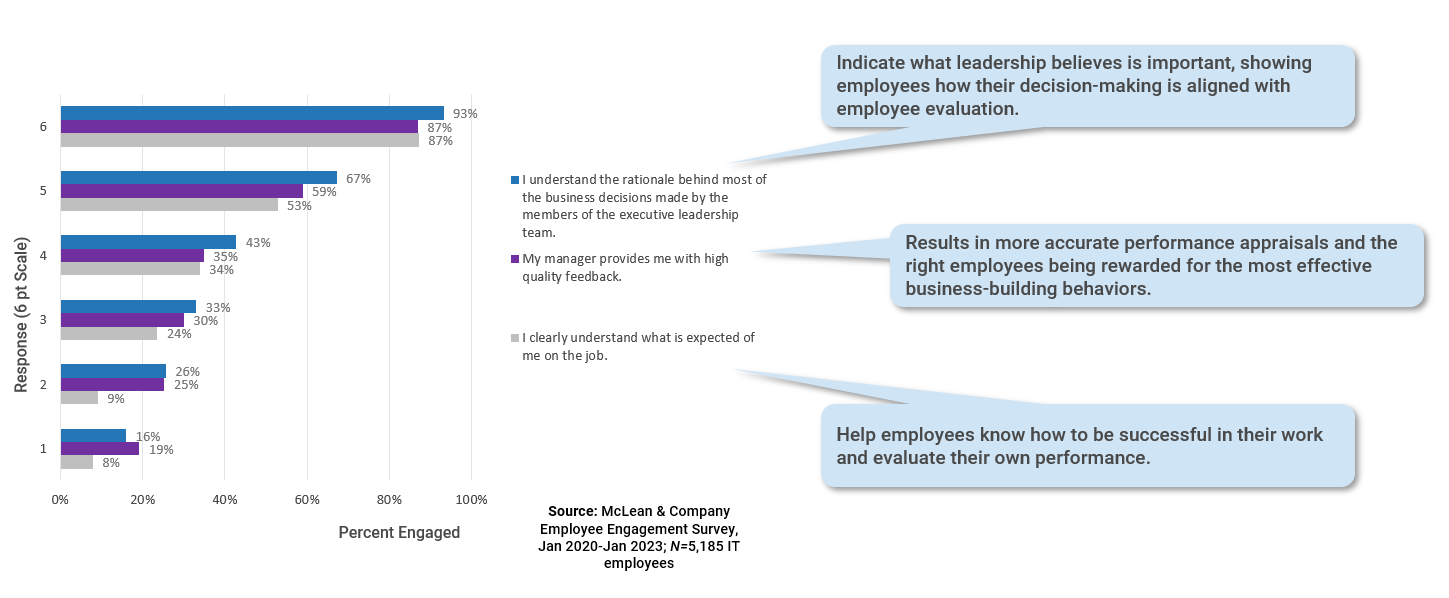
Which, in turn, drives business success.
Improved employee engagement is proven to improve employee performance. Setting meaningful measures can impact your bottom line.
Impact of Engagement on Performance
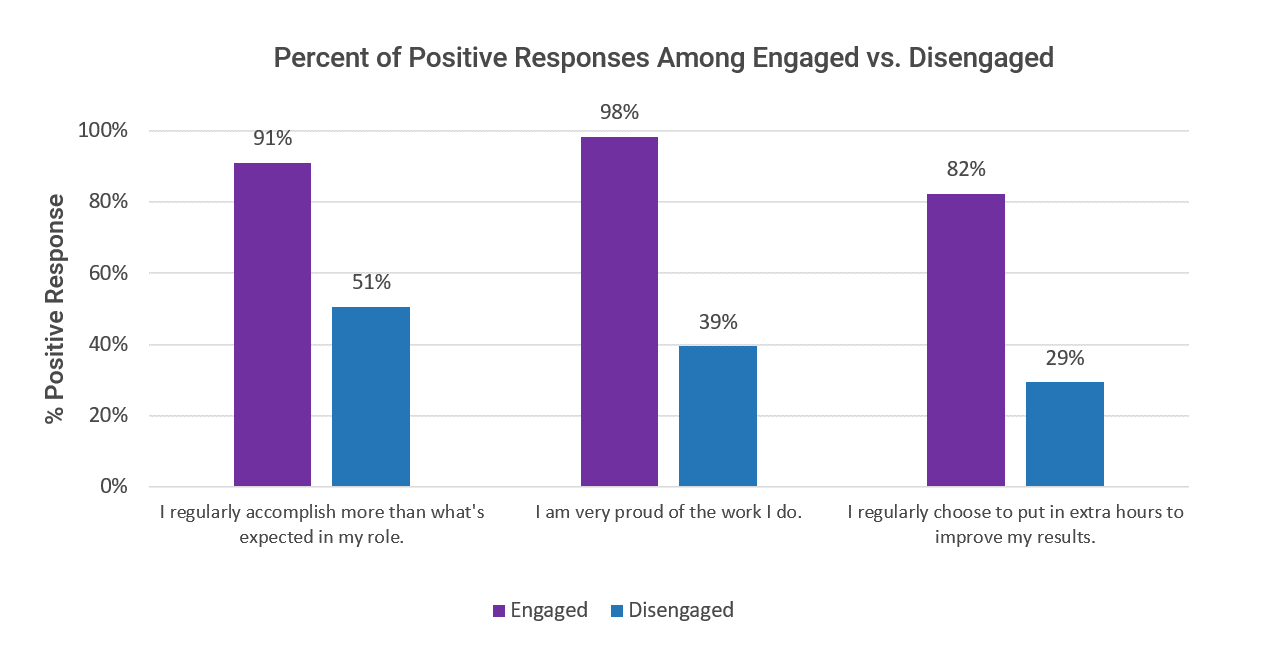
Source: McLean & Company Employee Engagement Survey Jan 2020-Jan 2023; N=5,185 IT Employees; were either Engaged or Disengaged (Almost Engaged and Indifferent were not included)
Engaged employees don’t just work harder, they deliver higher quality service and products.
Engaged employees are significantly more likely to agree that they regularly accomplish more than what’s expected of them, choose to work extra hours to improve results, and take pride in the work they do.
Without this sense of pride and ownership over the quality-of-service IT provides, IT departments are at serious risk of not being able to deliver quality service, on-time and on-budget.
Create meaningful performance measures to drive employee engagement by helping employees understand how they contribute to the organization.
Unfortunately, many employee measures are meaningless and fail to drive high-quality performance.
Too many ineffective performance measures create more work for the manager rather than inspire employee performance. Determine if your measures are worth tracking – or if they are lacking.
Meaningful performance measures are: |
Ineffective performance measures are: |
|
Clearly linked to organizational mission, values, and objectives. Based on a holistic understanding of employee performance. Relevant to organizational decision-making. Accepted by employees and managers. Easily understood by employees and managers. Valid: relevant to the role and goals and within an employee’s control. Reliable: consistently applied to assess different employees doing the same job. |
Difficult to track, update, and communicate. Easily gamed by managers or employees. Narrowly focused on targets rather than the quality of work. The cause of unintended outcomes or incentive for the wrong behaviors. Overly complex or elaborate. Easily manipulated due to reliance on simple calculations. Negotiable without taking into account business needs, leading to lower performance standards. |
Adopt a holistic approach to create meaningful performance measurement
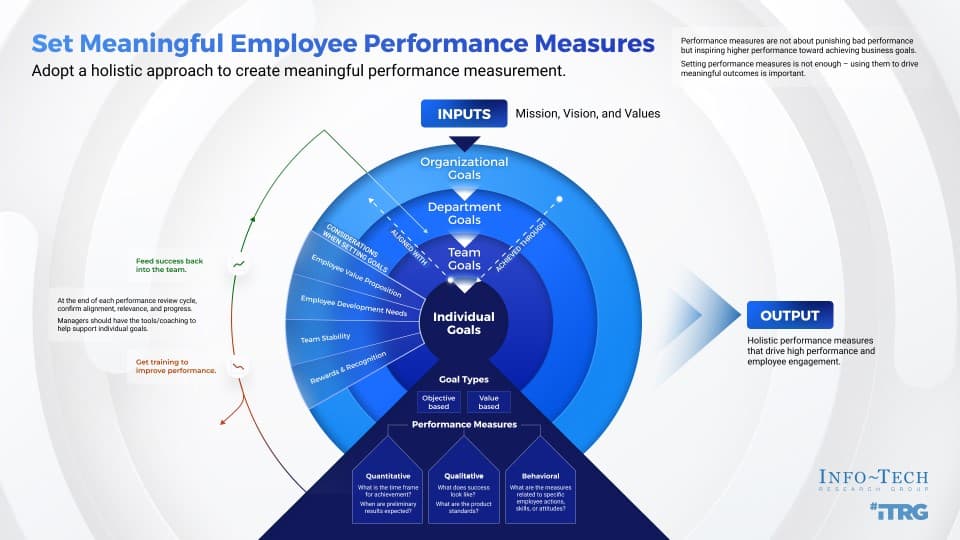
Info-Tech’s methodology to set the stage for more effective employee measures
1. Source and Set Goals
Phase Steps
1.1 Create business-aligned department and team goals
1.2 Create business-aligned individual goals
Phase Outcomes
Understand how your department contributes to larger organizational goals.
Determine the timelines you need to measure employees against.
Set business-aligned department, team, and individual goals.
2. Design Measures
Phase Steps
1.1 Choose measurement framework
1.2 Define employee measures
1.3 Determine weightings
Phase Outcomes
Choose your employee measurement framework: generic or individual.
Define appropriate employee measures for preestablished goals.
Determine employee measurement weightings to drive essential behaviors.
Ensure employee measures are communicated to the right stakeholders.
3. Communicate to Implement and Review
Phase Steps
1.1 Communicate to stakeholders
1.2 Coaching and feedback
1.3 When to update
Phase Outcomes
Communicate selected performance measure to stakeholders.
Learn how to coach employees though blockers.
Understand how to review and when to update measures.
Info-Tech offers various levels of support to best suit your needs
DIY Toolkit
"Our team has already made this critical project a priority, and we have the time and capability, but some guidance along the way would be helpful."
Guided Implementation
"Our team knows that we need to fix a process, but we need assistance to determine where to focus. Some check-ins along the way would help keep us on track."
Workshop
"We need to hit the ground running and get this project kicked off immediately. Our team has the ability to take this over once we get a framework and strategy in place."
Consulting
"Our team does not have the time or the knowledge to take this project on. We need assistance through the entirety of this project."
Diagnostics and consistent frameworks are used throughout all four options.
Guided Implementation
A Guided Implementation (GI) is a series of calls with an Info-Tech analyst to help implement our best practices in your organization.
A typical GI is four to six calls over the course of two to four months.
What does a typical GI on this topic look like?
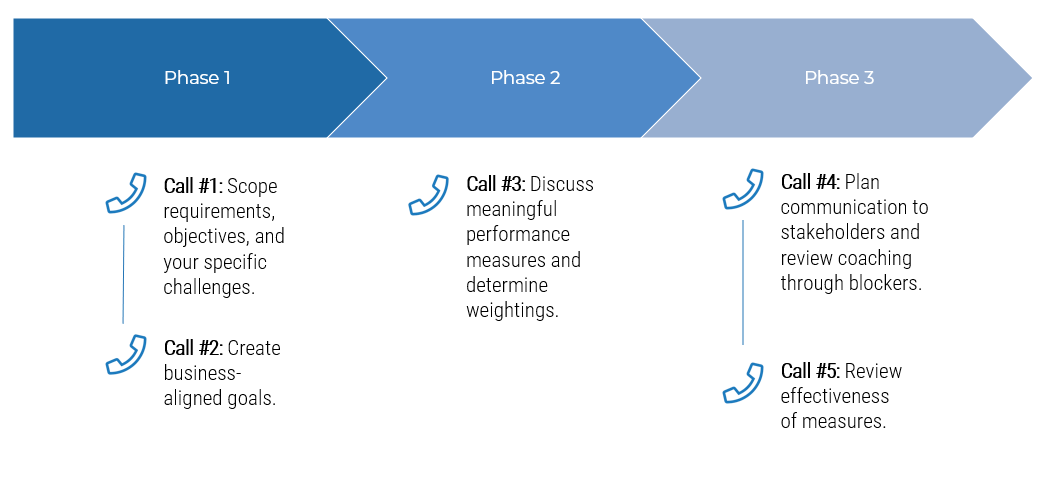
Buying Options
Set Meaningful Employee Performance Measures
Client rating
Cost Savings
Days Saved
IT Risk Management · IT Leadership & Strategy implementation · Operational Management · Service Delivery · Organizational Management · Process Improvements · ITIL, CORM, Agile · Cost Control · Business Process Analysis · Technology Development · Project Implementation · International Coordination · In & Outsourcing · Customer Care · Multilingual: Dutch, English, French, German, Japanese · Entrepreneur
Tymans Group is a brand by Gert Taeymans BV
Gert Taeymans bv
Europe: Koning Albertstraat 136, 2070 Burcht, Belgium — VAT No: BE0685.974.694 — phone: +32 (0) 468.142.754
USA: 4023 KENNETT PIKE, SUITE 751, GREENVILLE, DE 19807 — Phone: 1-917-473-8669
Copyright 2017-2022 Gert Taeymans BV